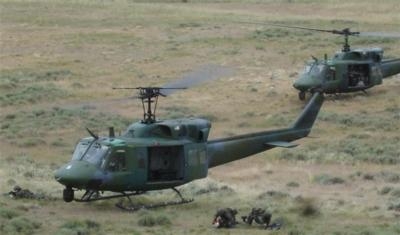Sun, Oct 26, 2014
UH-1N Iroquois Helicopters Are Aging And Past Intended Lifespan
Air Force Global Strike Command's Helicopter Operations Division hosted the Worldwide Helicopter Conference at Barksdale AFB in Louisiana Oct. 7-9, to discuss the current and future state of the Air Force's helicopter fleets.

The conference promoted cross talk among the Air Force's helicopter forces, which are principally operated by Air Combat Command, Pacific Air Forces, the Air Force District of Washington and AFGSC.
AFGSC, PACAF and AFDW operate a fleet of UH-1N Iroquois helicopters whose missions include surveillance of off-base nuclear weapons convoys, support of the Nuclear Security and Continuity of Operations/Continuity of Government missions and distinguished visitor airlift.
However, the UH-1N is an aging platform, operating well past its intended lifespan, said Col. Todd Worms, the AFGSC Helicopter Operations Division chief. To continue safe, secure and effective operations, a more capable platform is required.
ACC currently operates the HH-60G Pave Hawk to fulfill the Air Force's requirement to provide personnel recovery capability for its own forces as well as other Defense Department forces in hostile or isolated environments.
"We find that even though we're divided up into two operations, pretty much what affects one half affects the other; to include deployments, personnel shortfalls and maintenance issues," Worms said. "This is the one time each year we get to sit down and discuss all those issues with the commanders and the leadership from both sides to make sure we balance impacts across the force, come up with innovative ideas and exchange best practices. Budget restrictions resulted in the conference being cancelled in 2012 and 2013, making this year's information cross flow extremely beneficial."
Although the helicopter community is split across two platforms, the lessons learned from either side can greatly impact the future of the other.
"The Air Force's helicopter community is critical to a number of missions, and a common forum to address current and future issues is important to the Airmen who execute those missions," said Col. Charles Tomko, the ACC Personnel Recovery Division chief. "As we move forward with the Combat Rescue Helicopter Program, we will continue to work with our other helicopter partners to ensure we are all successful as a community to execute the missions the Air Force and combatant commanders task us with."
Worms also highlighted areas that a common rotary-wing platform across the Air Force would improve, including reduced training and maintenance costs, personnel efficiencies and common logistical practices across the force.
One particular area where commonality could be felt is in the helicopter training program.
The training that helicopter pilots go through currently requires aircrews to go through additional training when they transition between the UH-1 and the HH-60. A topic of discussion during the conference was how the Air Force can improve the process, avoiding the added cost of operating two separate platforms.
Currently, the goal is to have one rotary-wing platform for the Air Force. "If we buy the right things and make the right moves, we have an opportunity to build a much more capable and flexible helicopter force at a lower cost," Worms said.
ANN Salutes 1st Lt Christopher Mesnard, Air Force Global Strike Command Public Affairs.
(Image from file)
More News
Aero Linx: Model Aeronautical Association of Australia MAAA clubs are about fun flying, camaraderie and community. For over 75 years, the MAAA has been Australia’s largest fl>[...]
Touchdown Zone Lighting Two rows of transverse light bars located symmetrically about the runway centerline normally at 100 foot intervals. The basic system extends 3,000 feet alon>[...]
“Discovery and innovation are central to our mission at Virgin Galactic. We’re excited to build on our successful record of facilitating scientific experiments in subor>[...]
How To Get A Story On Aero-TV News/Feature Programming How do I submit a story idea or lead to Aero-TV? If you would like to submit a story idea or lead, please contact Jim Campbel>[...]
Student Pilot Reported That During Rotation, “All Of A Sudden The Back Of The Plane Kicked To The Right..." Analysis: The student pilot reported that during rotation, “>[...]
 ANN's Daily Aero-Linx (05.02.24)
ANN's Daily Aero-Linx (05.02.24) ANN's Daily Aero-Term (05.02.24): Touchdown Zone Lighting
ANN's Daily Aero-Term (05.02.24): Touchdown Zone Lighting Aero-News: Quote of the Day (05.02.24)
Aero-News: Quote of the Day (05.02.24) ANN FAQ: Contributing To Aero-TV
ANN FAQ: Contributing To Aero-TV NTSB Final Report: Cirrus Design Corp SR20
NTSB Final Report: Cirrus Design Corp SR20



